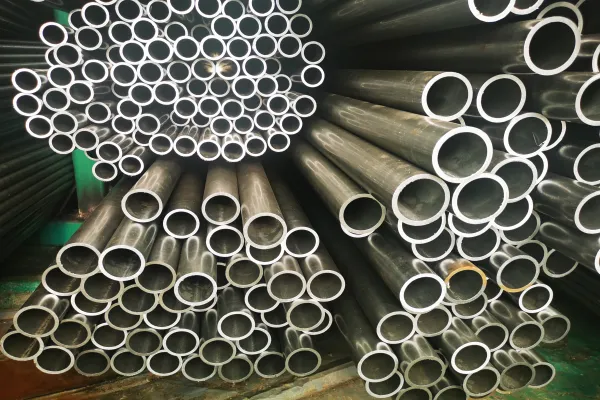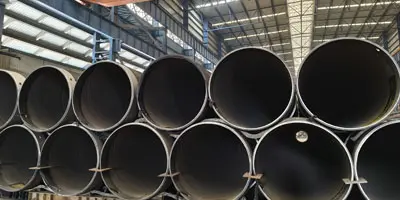Precision seamless pipes are widely used in high-precision industries such as automobiles, aviation, and hydraulics, and their quality requirements are extremely strict. However, during the production process, rolling cracking problems often occur, affecting the strength and service life of the pipe. This article will analyze the main causes of rolling cracking of precision seamless pipes and propose corresponding preventive measures.
1. The hot rolling cracking position of thick-walled seamless steel pipe is 38 and 118 meters away from the head of the strip, mainly in the middle of the strip.
2. It is inferred from the large hole morphology of rolling cracking that the crack starts in the middle of the strip width. The reason is that the rolling force and shear force during rolling cause the crack to stretch and form an obvious macroscopic large hole morphology.
33 The fracture surface of the broken strip of seamless steel pipe is smooth during the cold rolling production process, and no obvious surface defects are found before and after the fracture.
4 The microscopic morphology of the fracture is observed, and the typical dimple-like ductile fracture morphology can be seen. At the same time, the fracture is layered, the central dimple is larger, and the dimple near the surface is reduced. The crack shows a divergent expansion fracture morphology dominated by the central fracture, and the fracture depth at the center is deeper. It is inferred that the layered morphology of this broken strip is closely related to the central segregation.
Cause analysis of the precision seamless tube thick-walled seamless steel tube:
1. The morphology of the
hot-rolled cracking defects of the seamless steel tube was observed under a scanning electron microscope, and obvious cracks were visible in the middle of the fracture.
2. Further observation of the hot-rolled cracking cracks and their ends of the thick-walled seamless steel tube revealed that there were obvious oxidation particles near the cracks, and there were intragranular cracks at the ends of the cracks, and a complete polygonal ferrite morphology was present near the cracks.
3. The characteristics of the oxidation particles within 30um near the cracks are closely related to the original defects of the continuous casting billet. The continuous casting billet is heated for a long time in the heating furnace, causing the elements near the cracks to be oxidized, forming a thicker oxidation particle layer, and this defect is eventually inherited to the subsequent hot coils.
4. Analysis found that there were obvious cracks and oxidation zones at the center and 1/4 of the thickness, and there were also oxidation particles near the cracks.

The entire roll of this fracture had internal cracks of varying degrees. The cracks mainly existed near the precision seamless pipe part of the plate roll, showing a continuous through morphology, and the risk of rolling cracks was high.
According to the market, the recent arrival of steel mill resources is relatively sufficient, but due to the limited purchasing power of downstream terminals, the market destocking speed is slow, and most merchants have lowered prices to increase shipments. In addition, the local inventory increased slightly last week, and the arrival of steel mills continued to increase. Under the condition of poor demand, it is expected that the market of Lecong precision seamless pipes will continue to be weak and low.
Round tube billet → heating → perforation → heading → annealing → pickling → oiling (copper plating) → multiple cold drawing (cold rolling) → billet tube → heat treatment → straightening → water pressure test (defect detection) → marking → storage.
The first three steps of their production process are basically the same. The difference starts from the fourth step. After the round tube billet is hollowed out, it needs to be headed and annealed. After annealing, it needs to be acid-washed with a special acid liquid. After pickling, it needs to be oiled, and then it is followed by multiple cold drawing (cold rolling) and then billet tube, special heat treatment, and after heat treatment, it needs to be straightened.
After straightening, the steel pipe is sent to the metal flaw detector (or water pressure test) by the conveyor belt for internal flaw detection. If there are cracks, bubbles and other problems inside the steel pipe, they will be detected. After the quality inspection of the steel pipe, it must pass strict manual selection. After the quality inspection of the steel pipe, the number, specification, production batch number, etc. are sprayed with paint.
At that time, the impact of power shortage on the national steel supply and demand pattern was still limited. The output of 35crmo thick-walled seamless steel pipes in power-scarce areas accounted for about 20% of the national output. Although the power shortage was in a severe situation, large-scale "power outages" did not occur. Some of the measures introduced at that time to alleviate the power shortage were mainly concentrated on staggered production, so the impact on the national steel supply and demand pattern was relatively limited.






 English
English Español
Español بالعربية
بالعربية











 Phone :
Phone :  Whatsapp :
Whatsapp :  Email :
Email : 


